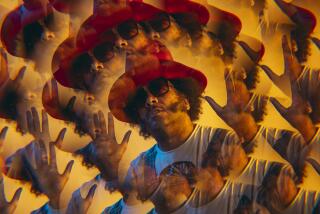Levitate! : MR. VERTIGO, <i> By Paul Auster (Viking: $21.95; 292 pp.)</i>
- Share via
Throughout his career as a novelist, Paul Auster has been making a fictional map of the United States, carefully pinning his characters to real places--to specific city streets, small towns and stretches of highway. In this new novel, Auster takes us to the Midwest in the 1920s and ‘30, but this time his map includes a portion of the Kansas sky.
“I was 12 years old the first time I walked on water,” begins the narrator of “Mr. Vertigo.” He is Walter Rawley, and though he likes an occasional wisecrack, he’s telling us the truth here. “Walt the Wonder Boy,” as he is nicknamed, does walk on water in this novel. He flies. He climbs up invisible staircases and over bridges that don’t exist. He somersaults in midair, falls, brakes inches above the ground and floats down to earth. He is the supreme vaudevillian, a nearly flawless entertainer and his greatest act is the story he tells us, the story of his life.
Paul Auster has always been intrigued by games, and the fact that he is playing with the rules of realism in this novel seems a natural development, given his earlier sleight of hand. He’s a sly realist, a writer who asks us to lose ourselves totally in the illusion of his fiction even as he exposes the artifice. This is part of the joy of reading Auster’s work--his stories are absorbing, his insights jolting.
“Mr. Vertigo” is surely one of Auster’s most absorbing tales, written in a prose that is precise, confident in its use of vernacular and sometimes smoothly lyrical, as in this description of a Kansas drought: “The air was so parched, so delirious in its desiccation, you could track the buzzing of a horsefly from a hundred yards away.” Reaching from old age back through memory, Auster’s narrator recounts his life, miracle by miracle, beginning in 1924, when the mysterious Master Yehudi enters Walt’s life. Walt is only 9, an orphan living with a wicked uncle and an indifferent aunt. Master Yehudi offers a rather primal proposition to young Walt: “‘If I haven’t taught you to fly by your 13th birthday, you can chop off my head with an axe.”’ Since Walt has no better prospects, he accepts the challenge and goes to live with Master Yehudi on a farm in rural Kansas. There he meets Mother Sue, a Sioux Indian, and Aesop, an Ethiopian boy, both of whom are indebted to Yehudi for their lives.
Walt joins this makeshift family weighted down with the burden of provincial bigotry. He identifies Mother Sue as the “Queen of the Gypsies” and Aesop as the “Prince of Blackness.” It doesn’t take him long to give up his prejudices, though. Walt attempts to escape Master Yehudi’s harsh regimen and runs away several times. His last failed attempt ends in illness, and his recovery is marked by a vast shift in attitude. He forgets his earlier prejudices and comes to consider Aesop and Mother Sue his best friends. This improvement--too complete, too convenient, even for Auster’s modern fairy tale--may be the one significant weakness of the novel. Walt gives up his dangerous bigotry as easily as an old coat, replacing it with loyalty and deep respect. The snarling, distrustful boy suddenly becomes likable, a transformation that ends up seeming more unreal than his levitations.
That complaint aside, Walt’s catalogue of initiating terrors is unforgettable. In order to achieve some kind of psychic control over gravity, he must endure a variety of tortures. “I was flogged with a bullwhip; I was thrown from a galloping horse; I was lashed to the roof of the barn for two days without food or water; I had my skin smeared with honey and then stood naked in the August heat as a thousand flies and wasps swarmed over me. . . .” The list goes on. Somehow Walt manages to survive Master Yehudi’s initiation. And at last, in his moment of deepest despair, he feels his body rise a few inches into the air.
With practice, Walt learns to control his flights, to turn levitation into a graceful dance. But his magical buoyancy has little consequence--it is entertainment, stupendous entertainment. Walt is no more than a boy with an amazing trick up his sleeve. His magic can’t help him when the Ku Klux Klan rides in. He cowers with Yehudi behind a tree and witnesses terrors that far surpass the cruelties of his initiation.
The road has always been a useful metaphor for Auster--it is a means of escape and pursuit, as well as an image for the motion of thought. Walt and Yehudi take their show on the road and escape the Klan’s destruction. At the same time they head out in pursuit of fame, fighting their way into the limelight. Walt the Wonder Boy becomes a national celebrity, though only for a few short years. Levitation, it turns out, is a kind of magic that belongs only to children (and to eunuchs, Master Yehudi intimates). When Walt enters puberty, the effort of flying becomes unbearably excruciating and he is forced to abandon the show.
Walt all but abandons his singular self as well. No longer a curiosity, he becomes a type--a slick nightclub owner obsessed with guns and baseball. If Walt seems less interesting as an adult, less original, it is not a fault of the novel. It is the fault of the culture, which offers the earthbound young man few prospects and permits no miraculous escape.
“Very slowly, I felt my body rise off the floor. The movement was so natural, so exquisite in its gentleness, it wasn’t until I opened my eyes that I understood my limbs were touching only air,” Walt says about his first levitation. But as soon as the magic is over, Walt sinks “like a stone to the bottom of the world.” “Mr. Vertigo” is a thrilling flight of fancy that never abandons the world. A magical-pertinent book, it gives us a bird’s-eye view of the strange, violent, paradoxical century behind us.
More to Read
Sign up for our Book Club newsletter
Get the latest news, events and more from the Los Angeles Times Book Club, and help us get L.A. reading and talking.
You may occasionally receive promotional content from the Los Angeles Times.







